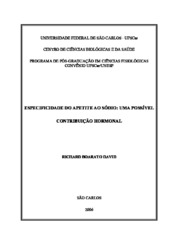Especificidade do apetite ao sódio: uma possível contribuição hormonal
Resumen
The hypothesis of a synergy between two hormones responsible for sodium
conservation, aldosterone and angiotensin II (ANG II), explains the expression of a
characteristic of sodium appetite, hypertonic NaCl intake, in a hypovolemic animal.
Hypertonic NaCl intake can be induced in normovolemic rats that received a combined
treatment of mineralocorticoid and ANG II at individual doses not sufficient to induce sodium
intake (paradigmatic synergy test). Considering the motivation to specific sodium intake
another characteristic of sodium appetite, the objective of the present dissertation was to find
out a role for the interaction between mineralocorticoid and ANG II on the specificity of
sodium appetite.
Sprague-Dawley Holtzman rats (≅ 300 g b.w.) were housed with access to water and
one or more palatable (0.01 M KCl, 0.05 mM CaCl2, 0.15 M NaHCO3, 0.15 M NaCl) or
hypertonic (0.50 M NaCl) mineral solutions for ingestion. In two-bottle tests, a bottle
contained water and another bottle contained either 0.01 M KCl, 0.15 M NaHCO3, 0.15 M
NaCl or 0.50 M NaCl. In five-bottle tests, a bottle contained water and each one of the
remaining four bottles contained either 0.01 M KCl, 0.05 mM CaCl2, 0.15 M NaHCO3 or 0.15
M NaCl, respectively.
In sodium depletion tests, intact rats received each a 10 mg sc. injection of furosemide
or vehicle followed by 24 h access to sodium deficient food and water. Then, food was
removed and mineral solutions and water were offered for recording their intake (sodium
appetite test). In the paradigmatic synergy test, the animals received daily single sc injection
of 2.5 mg of deoxycorticosterone acetate (DOCA) or sunflower oil (vehicle) for three days
and a left lateral cerebroventricular injection of 50 ng of ANG II four hours after the last
DOCA or oil injection. Fluid intake record began immediately after ANG II injection and
food removal.
The daily intake record showed no preference for any solution or water when animals
had access to five bottles. Sodium depletion induced a preferential sodium intake, with higher
NaCl than NaHCO3 intake, in either two- or five-bottle sodium appetite tests. DOCA alone
enhanced the daily 0.15 M NaCl and NaHCO3 intake, but did not alter KCl or 0.50 M NaCl
intake in two-bottle tests. In the paradigmatic tests with normovolemic animals, ANG II
combined to oil induced the ingestion of all three palatable mineral solutions (KCl, NaHCO3,
NaCl) and water, in two-bottle tests, and preference for NaHCO3 in five-bottle tests. DOCA
pretreatment enhanced only sodium solution intake, particularly NaCl intake, induced by
ANG II in two-bottle tests (0.15 M NaCl: DOCA/ANG II = 24.5 ± 6.7 ml/120 min. vs.
OIL/ANG II = 9.2 ± 1.8 ml/120 min.; 0.15 M NaHCO3: DOCA/ANG II = 17.0 ± 1.8 ml/120
min. vs. OIL/ANG II = 14.6 ± 2.1 ml/120 min.; 0.01 M KCl: DOCA/ANG II = 9.8 ± 1.9
ml/120 min. vs. 11.9 ± 1.2 ml/120 min.), and enhanced by 80 % the total sodium solution
intake in the beginning of the five-bottle test. The combined effect of DOCA with ANG II on
the induction of 0.50 M NaCl intake in a two-bottle test was replicated in our animals.
The results from the paradigmatic synergy test are coherent with results from sodium
appetite tests, suggesting that the mineralocorticoid may turn the effect of ANG II on mineral
intake more selective to sodium intake. Thus, the combined ANG II and mineralocorticoid
action could contribute to the expression of two characteristics of sodium appetite, not only
the acceptance of hypertonic sodium solutions, but also the selective sodium intake.
